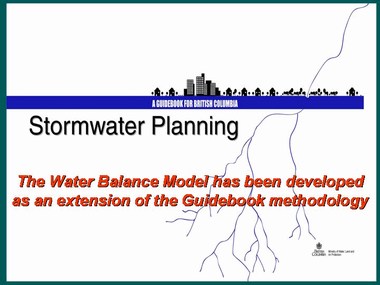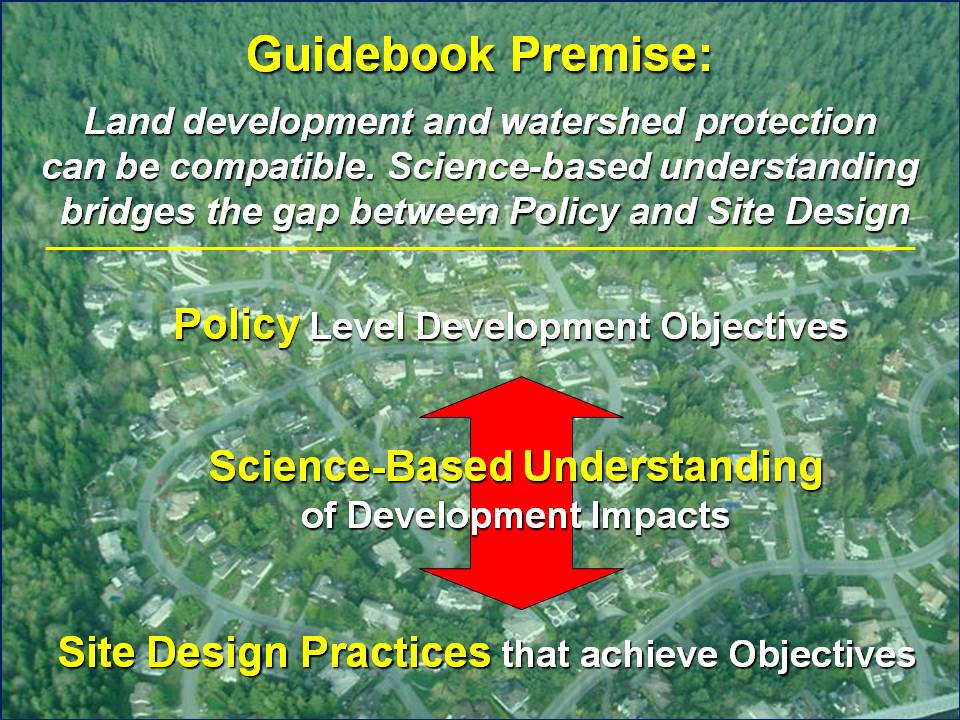A Perspective on Leading Change: “Bring the right people together at the right time,” stated Environment Canada’s Laura Maclean at 2007 Water Balance Model Partners Forum
Note to Reader:
The Water Balance Model is the centrepiece of the Water Sustainability Action Plan for British Columbia. In March 2007, the Inter-Governmental Partnership held a Water Balance Model Partners Forum so that local government partners could share success stories and lessons learned in implementing green infrastructure.
Genesis of the Water Balance Model for British Columbia
The desire to mitigate environmental impacts has provided a driver for the ‘green infrastructure’ movement in British Columbia. This movement is water-centric, is founded on a natural systems approach, and is influencing infrastructure policies, practices and standards.
An Extension of BC’s Stormwater Guidebook
In 2001 the Stormwater Interagency Liaison Group (SILG), a technical committee of the Greater Vancouver Regional District, recognized the value of the water balance approach and funded the development of a working model to assess the affordability and feasibility of site design solutions for achieving performance targets.
The results of this applied research were incorporated in Stormwater Planning: A Guidebook for British Columbia, funded in large part by Environment Canada and released by the Province of British Columbia in June 2002. This guidance document, founded on BC case study experience, formalized a science-based understanding to set performance targets for reducing rainwater runoff volumes.
In July 2002 the Inter-Governmental Partnership (IGP) was formed to develop the Water Balance Model (WBM) as an extension of the Guidebook. It began as a subgroup of SILG and quickly expanded to become a provincial group with municipal representation from four regions: Greater Vancouver, the Fraser Valley, Vancouver Island and the Okanagan Valley.

Importance of Relationship-Building
At the Water Balance Model Partners Forum convened by the Inter-Governmental Partnership (IGP) in March 2007, Partners shared success stories and lessons learned in implementing green infrastructure.
Hosted by the Greater Vancouver Regional District, the Partners Forum also provided a timely opportunity to roll out ‘Beyond the Guidebook’, a runoff-based approach to drainage modeling that connects the dots between source control evaluation and stream health assessment.
Integration of QUALHYMO Engine with
Water Balance Model Interface
“ To sustain the early success of the Water Balance Model, and to advance ‘sustainable drainage’ initiatives across Canada, the Ministry of Agriculture & Lands provided the IGP with $160,000 to expand the capabilities of the Water Balance Model by integrating it with QUALHYMO, a rainfall-runoff model developed by Dr. Charles Rowney in the early 1980s. This means engineers will be able to model the storage and routing of outflows from a subdivision and/or neighbourhood through a detention pond or down a stream channel”, stated Ted van der Gulik, IGP Chair.
To sustain the early success of the Water Balance Model, and to advance ‘sustainable drainage’ initiatives across Canada, the Ministry of Agriculture & Lands provided the IGP with $160,000 to expand the capabilities of the Water Balance Model by integrating it with QUALHYMO, a rainfall-runoff model developed by Dr. Charles Rowney in the early 1980s. This means engineers will be able to model the storage and routing of outflows from a subdivision and/or neighbourhood through a detention pond or down a stream channel”, stated Ted van der Gulik, IGP Chair.
Creating and Leading Change
Laura Maclean (Environment Canada), Co-Chair of the IGP, provided this context when she reflected on the factors that contributed to the early success of the WBM initiative:
“The experience of the Greater Vancouver region shows how important it is to have  a way to bring the right people together at the right time, and in so doing build a network that can make things happen. Looking back, much of what we have collectively accomplished in recent years in the field of rainwater management can be traced back to relationships that were formed through the GVRD’s Stormwater Interagency Liaison Group (SILG). In fact, development of the first spreadsheet version of the Water Balance Model was funded by SILG in 2001.”
a way to bring the right people together at the right time, and in so doing build a network that can make things happen. Looking back, much of what we have collectively accomplished in recent years in the field of rainwater management can be traced back to relationships that were formed through the GVRD’s Stormwater Interagency Liaison Group (SILG). In fact, development of the first spreadsheet version of the Water Balance Model was funded by SILG in 2001.”
“We now see a comparable relationship-building process taking shape on Vancouver Island with the formation of the inter-agency Water Balance Coordinating Team co-chaired by Jay Bradley, Ministry of Agriculture & Lands, and Chris Jensen, Ministry of Community Services. Looking ahead, the IGP anticipates that this may be the template for other regional initiatives.”
To Learn More:
To read the complete and comprehensive story about the 2007 Forum, click on Inter-Governmental Partnership Rolls Out ‘Beyond the Guidebook’ at Water Balance Model Forum



